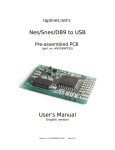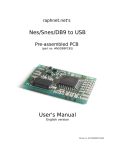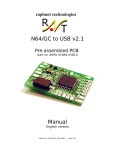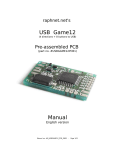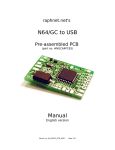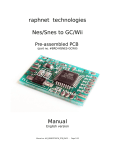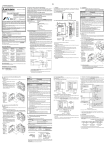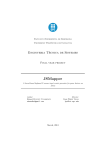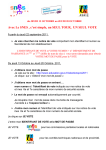Download raphnet.net`s Nes/Snes/DB9 to USB
Transcript
raphnet.net's Nes/Snes/DB9/TG16 to USB Pre-assembled PCB (part no. #BRD-NSDB9-USB) Owners Manual English version Manual no. #M_NDSB9PCB_ENG3 (2008-12-22) - Page 1/14 Table of Contents 1) Introduction.........................................................................................................3 1.1) Product summary..........................................................................................3 1.2) Supported operating Systems.......................................................................3 1.3) Supported controllers....................................................................................3 2) Getting started....................................................................................................4 2.1) What you should have received....................................................................4 2.2) Required material (not included)..................................................................4 2.3) Recommended equipment............................................................................4 2.4) Overview of installation................................................................................5 3) Controller type selection......................................................................................6 3.1) Enabling SNES mode.....................................................................................6 3.2) Enabling NES mode.......................................................................................6 3.3) Enabling DB9 mode......................................................................................6 3.4) Enabling TurboGrafx-16/PC-Engine mode.....................................................6 4) Assembly.............................................................................................................7 4.1) Soldering USB wires (common to all controller types)..................................7 4.2) Soldering SNES controller wires....................................................................8 4.3) Soldering NES controller wires......................................................................8 4.4) Soldering DB9 controller wires......................................................................9 4.5) Soldering TurboGrafx16 (and equivalents) wires........................................10 5) Installation.........................................................................................................11 5.1) Installation under Windows.........................................................................11 5.2) Installation under Mac OS X........................................................................11 5.3) Installation under Linux..............................................................................12 6) Operating notes.................................................................................................13 6.1) In SNES mode.............................................................................................13 NES controller detection.................................................................................13 Mouse support................................................................................................13 6.2) In DB9 mode...............................................................................................13 7) Copyright, Disclaimer and History.....................................................................14 7.1) Copyright....................................................................................................14 7.2) Disclaimer...................................................................................................14 7.3) Revision history...........................................................................................14 Manual no. #M_NDSB9PCB_ENG3 (2008-12-22) - Page 2/14 1) Introduction 1.1) Product summary This circuit converts one of the supported game controllers to a standard USB HID compliant input device. It can be installed inside a controller or used to build an adapter. 1.2) Supported operating Systems Many operating systems support USB HID joysticks. This product is known to work with at least the following operating systems: ● Linux kernel 2.4 and 2.6 ● Mac OS X ● Microsoft Windows 98/ME (recent version of Direct X recommended) ● Microsoft Windows 2000/XP/Vista 1.3) Supported controllers ● Snes controllers and Snes mouse (auto detected) ● Nes controllers ● Sega Genesis 3 and 6 button controllers ● Genesis multi-taps (Use 4 controllers with one adapter!). Models MK-1647, MK-1654 and P-450 were tested. ● Sega master system controllers and compatible two button joysticks such as Amiga digital joysticks. ● Atari 2600 one-button compatible joysticks. ● TurboGrafx-16 (also PC-Engine and Duo) controller support. Tested with HESPAD-01 and PI-PD8 models. Manual no. #M_NDSB9PCB_ENG3 (2008-12-22) - Page 3/14 2) Getting started 2.1) What you should have received 1. One two-sided PCB. The actual number of components and board markings will vary across different board revisions. Top layer Bottom layer 2.2) Required material (not included) 1. Soldering equipment. 2. Basic electronic tools. (cutters, wire strippers, tweezers) 3. Multimeter for testing continuity. 4. USB cable with an USB male connector (type A) on one side, and bare wires at the opposite side. You may cut a cable in two parts to obtain this. 5. If you plan to build an adapter (instead installing the circuit inside a controller), you will need a connector that mates with your controller. This can come from an extension cord, a broken console, or an electronic component store (likely for DB9 connectors). 6. Again, if building an adapter, some kind of enclosure to protect the circuit is highly recommended. This is especially important to prevent the circuit from coming in contact with anything metallic such as a computer case. This could cause a short circuit which could likely cause damages to the circuit or your computer, depending on circumstances. 2.3) Recommended equipment 1. Desoldering braid (just in case) 2. Hot glue gun and Hot glue (to prevent the wires from eventually breaking at the point where they are soldered). Especially important if the wires may move. Manual no. #M_NDSB9PCB_ENG3 (2008-12-22) - Page 4/14 2.4) Overview of installation 1. Start by carefully planning how you will install the circuit inside the controller (or your enclosure). Make sure you dont cut the wires too short and that the circuit will not be in the way when you put back the cover. 2. Configure the circuit for your controller type (see Chapter 3) 3. Install the USB wires (see Chapter 4, section 1) 4. Install your controller wires (see Chapter 4, section 2 and on) 5. Inspect for shorts. Double-checking with a multimeter is recommended if you have any doubts. 6. Test on a computer. If it does not work, double check everything and then contact me. 7. Install hot glue over the solder points. 8. Insulate any metal part (e.g. USB cable shield) which could come in contact with the Circuit. Use electric tape or hot glue. 9. Finish the installation. (Close enclosure) 10. Play! Manual no. #M_NDSB9PCB_ENG3 (2008-12-22) - Page 5/14 3) Controller type selection The circuit supports 3 different modes (SNES, NES and DB9 mode). The mode is selected by connecting (or not connecting) parts of JP1 and JP2. JP1 and JP2 are checked by the firmware at power-up or reset. 3.1) Enabling SNES mode Snes mode is enabled by not connecting anything. 3.2) Enabling NES mode Nes mode is enabled by connecting JP1 pads together. 3.3) Enabling DB9 mode DB9 mode (for Genesis controllers and multi-taps, SMS, Atari and compatibles) is enabled by connecting JP1 and JP2 together as shown on the picture: 3.4) Enabling TurboGrafx-16/PC-Engine mode TurboGrafx-16, PC-Engine and Due mode is enabled by connecting across JP2 only. Manual no. #M_NDSB9PCB_ENG3 (2008-12-22) - Page 6/14 4) Assembly 4.1) Soldering USB wires (common to all controller types) The USB standard dictates the color code that shall be used inside an USB cable. This means that normally, all you need to do is to solder the wires exactly as they are on the picture. The White wire should be soldered to the pad labelled W, the green wire to the pad labelled G, the black wire to the pad labelled – (minus), and the red wire to the pad labelled + (plus). Warning: Some rare USB cables dont follow the standard color code. If the cable you use has additional wires, if any color is different, or if you have doubts, check the pinout with a multimeter. Mis-wiring may cause damage to your computer, to this circuit or to the controller. Here is the standard USB pinout Pin 1 Red 5 volts Pin 2 White D- Pin 3 Green D+ Pin 4 Black Ground Manual no. #M_NDSB9PCB_ENG3 (2008-12-22) - Page 7/14 4.2) Soldering SNES controller wires As far as I am aware, Nintendo brand controllers all use the same color code. Many clones also use this convention too, but not all. If your controller uses the standard color code, you can follow the diagram on the right. (Note that the SNES and NES color codes are different). If you're not sure about your controller, check it's pinout with a multimeter and use the table and picture below for wiring: Pin Function Standard color Connect to 1 5 volts White + 2 Clock Yellow PC5 3 Latch Orange PC4 4 Data Red PC3 7 Ground Brown Note: Pin numbers were arbitrarily assigned. They do not match any known standard or convention. 4.3) Soldering NES controller wires As far as I am aware, Nintendo brand controllers all use the same color code. Many clones use this convention too, but not all. If your controller uses the standard color code, you can follow the diagram on the right. (Note that the SNES and NES color codes are different). If you're not sure about your controller, check it's pinout with a multimeter and use the table and picture below for wiring: Pin Function Standard color Connect to 1 Ground Brown - 2 Clock Red PC5 3 Latch Orange PC4 4 Data Yellow PC3 7 5 volts White + Note: Pin numbers were arbitrarily assigned. They do not match any known standard or convention. Manual no. #M_NDSB9PCB_ENG3 (2008-12-22) - Page 8/14 4.4) Soldering DB9 controller wires There are too many different kind of controllers using DB9 connectors to talk about a standard color code. Fortunately, cutting your controller cable is far from necessary in this case. It is best to use easy to find solder cup DB9 connectors. The original controller can thus be left intact. The picture on the right shows where to connect each DB9 pin on the board. Solder cup DB9 male connectors Here is a table summarizing what the wires are used for with different type of DB9 controllers. Pin Genesis 3 Genesis 6 SMS Atari 2600 1 Up Up or Z Up Up 2 Down Down or Y Down Down 3 Left or 0 Left, 0 or X Left 4 Right or 0 5 Right +5volts 6 Button A or B 7 Select 8 Ground 9 Button Start or C Left Right Not used Button 1 Fire button Not used +5v, 50mA max. Button 2 Not used Manual no. #M_NDSB9PCB_ENG3 (2008-12-22) - Page 9/14 4.5) Soldering TurboGrafx16 (and equivalents) wires Some controllers use a DIN8 connector, others a MINI-DIN8 connector. Those connectors are standard and available in many electronic stores. Refer the the pictures below and use the table to to wire the conversion circuit correctly. Solder to Connector pin # Function PC5 2 Buttons UP and I PC4 3 Buttons RIGHT and II PC3 4 Buttons DOWN and SELECT PC2 5 Buttons LEFT and RUN PC1 6 Select button bank (input on controller) PC0 7 Enable controller (must be toggled for Turbos to work) - 8 Ground + 1 5 Volts power Mini DIN male (as on controller cord) Mini DIN female (as on console) DIN female (as on console) DIN male (as on controller cord) Manual no. #M_NDSB9PCB_ENG3 (2008-12-22) - Page 10/14 5) Installation Up to now, all operating systems this product was tested with had native support for USB HID joysticks and gamepads. Most of the time, connecting the adapter is all that has to be done before starting your game. (and then of course, you configure the game to use joysticks). But here are a few installation notes for different operating systems. 5.1) Installation under Windows When you connect the adapter for the first time, depending on your Windows version, a pop up may appear requesting that you insert your windows installation disc. Follow the instructions. After installation completes, you may be required to reboot your computer. Once the drivers are installed, the controller should appear in Control Panel -> Game controllers/ Gaming options every time you connect the adapter. 5.2) Installation under Mac OS X No installation instructions at the moment. No drivers are required, but the game or emulator you use must support USB Joysticks. You may use USB Prober to check for the device presence. USB Prober Manual no. #M_NDSB9PCB_ENG3 (2008-12-22) - Page 11/14 5.3) Installation under Linux Normally, the controller will work instantly. There are too many different Linux distributions to cover every possible scenarios, but here are a few ways to check if the adapter was detected correctly. After connecting your adapter, check dmesg for a message such as this one: [1439918.730644] usb 2-2.2: new low speed USB device using uhci_hcd and address 67 [1439918.862745] usb 2-2.2: configuration #1 chosen from 1 choice [1439918.887690] input: raphnet.net (S)NES/Atari_USB as /class/input/input75 [1439918.887749] input: USB HID v1.01 Gamepad [raphnet.net (S)NES/Atari_USB] on usb-0000:00:1a.1-2.2 Make sure the usb, input, hid and joydev modules are loaded (or compiled into your kernel). The device should appear /proc/bus/input/devices: # cat /proc/bus/input/devices ... I: Bus=0003 Vendor=1781 Product=0a96 Version=0101 N: Name="raphnet.net (S)NES/Atari_USB" P: Phys=usb-0000:00:1d.0-1.1/input0 S: Sysfs=/class/input/input72 U: Uniq=1000 H: Handlers=event3 js0 B: EV=b B: KEY=ff0000 0 0 0 0 0 0 0 0 0 B: ABS=3 Notice the 'js0' handler above. If you have more than one controller, this could be js1, js2... If no jsX handler is present, you need the joydev module. For testing the buttons and directions, you can use the jstest tool. Under debian, this is in the joystick package. # jstest ./js0 Driver version is 2.1.0. Joystick (raphnet.net (S)NES/Atari_USB) has 2 axes (X, Y) and 8 buttons (BtnX, BtnY, BtnZ, BtnTL, BtnTR, BtnTL2, BtnTR2, BtnSelect). Testing ... (interrupt to exit) Axes: 0: 0 1: 0 Buttons: 0:off 1:off 2:off 3:off 4:on 5:off 6:off 7:off Axes: 0: 0 1: 0 Buttons: 0:off 1:off 2:off 3:off 4:off 5:off 6:on Manual no. #M_NDSB9PCB_ENG3 (2008-12-22) - Page 12/14 7:off 6) Operating notes 6.1) In SNES mode NES controller detection If a NES controller is connected instead of an SNES controller, it should be autodetected. Auto-detection works with original Nintendo controllers, but may be unreliable with certain imitations. In this case, the adapter should be used in NES mode. Mouse support When SNES mode is selected and an SNES mouse is connected instead of a regular controller, the adapter will act as a standard USB mouse instead of a joystick. The SNES mouse supports 3 different speeds. The operating speed can be selected: ● High speed: Hold the right button down while connecting the mouse. ● Medium speed: Hold the left button down while connecting the mouse. ● Low speed: Hold the left and right buttons down while connecting the mouse. The default speed is 'Low'. If the mouse (but not the adapter) is disconnected during use and re-connected later, the previous speed is used. 6.2) In DB9 mode In this mode, the type of controller is auto-detected. At power-up (that is, when you connect the USB side of the adapter), a test is done to decide if the connected controller is a Genesis controller or and older SMS or Atari controller. If no controller is connected, the adapter will think there is a two button SMS or Atari compatible controller. If you connect a Genesis controller later, only two buttons will work. Note: If the 6 button auto-detection fails, the adapter can be forced into 6 button mode by holding the START button down while connecting the USB cable into the computer. Manual no. #M_NDSB9PCB_ENG3 (2008-12-22) - Page 13/14 7) Copyright, Disclaimer and History 7.1) Copyright All the information, pictures, diagrams, tables and texts contained in this manual is Copyright Raphaël Assénat, 2007-2008. All rights reserved. Partial or total reproduction is not permitted without the Copyright holder's written authorisation, except for personal use. Trademarks that are mentioned in this manual are the property of their respective owners. 7.2) Disclaimer Even though I made great efforts and a lot of testing to make sure my products are safe, I cannot be held responsible for any damage(s) or loss(es) caused directly or indirectly by the use of my products, including but not limited to, loss of data, loss of profit, computer/server downtime, device and peripheral damage or failure. While I believe that all the information contained in this manual is accurate, should any damage(s) occur due to error(s) in this manual, my responsibility will be limited to replacing my product if it is damaged. 7.3) Revision history November 1, 2007 January 27, 2008 First version of this manual. ● ● December 22, 2008 ● ● ● ● Documented the 'force 6 button mode' feature Removed old wiring diagrams to reduce file size. The diagrams will still be available, but in a separate file. Updated the two-sided board description (removed the component count which was different on latest boards) Documented the Genesis Multi-tap support. Documented the TurboGrafx-16/PC-Engine/Duo support Updated DB9 operating notes. Manual no. #M_NDSB9PCB_ENG3 (2008-12-22) - Page 14/14














